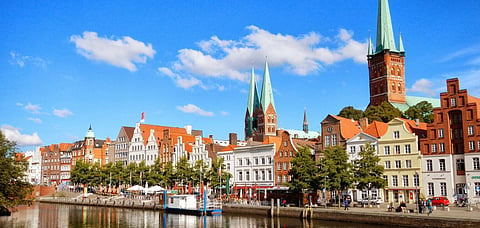
- Destinations
- Experiences
- Stay
- What's new
- Celebrating People
- Responsible Tourism
- CampaignsCampaigns
- SubscribeSubscribe
- Buy Now

Germany is a country of many picturesque and historical towns interspersed throughout stylish countryside and regal cityscapes. One of them is Lübeck. The Northern Germany city is an extraordinary store of brilliant architectural eras with its many churches and town halls, monasteries and streets.
UNESCO World Heritage Site
The city is a UNESCO World Heritage Site due to the Gothic, Renaissance, Baroque and Classicist buildings, narrow lanes and streets, churches and monasteries, merchants' houses, and fortifications that make up its incredible, history-rich geography. Lübeck has long been exceptional as one of the most major early global commerce cities. The five main churches and seven towers that make up the Old Town, which is surrounded by water, are evidence of the city's 1,000-year colourful history.
St. Mary's Church
This church is an excellent example of brick Gothic architecture and has the world's tallest brick vault. St. Mary&rsquos Church was built between 1265 and 1352, and is located on the highest point of Lübeck's old town island.
St. Catherine&rsquos Church
Another example of a brick Gothic church. The church was constructed in the early 14th century. Since 1980, the church which is part of the Lübeck World Heritage Site, has been used as a museum, church, and exhibition hall.
Castle Monastery
In the Medieval Ages, Lübeck had 4 monasteries. One of the most significant mediaeval monastery complexes in North Germany is said to be the Castle Monastery which forms a significant part of the city
Koberg Square
The Koberg square has changed its name so often during the centuries with old documents telling us about the Kauperg, then calling it the Kaufberg and by the end of the 18th century "Kuhberg" (which means "cow mountain"). Koberg square was dubbed the Geibelplatz in the late 19th century because Lübeck was so proud of its own poet, Emanuel Geibel. Today, the artist is all but forgotten, and his statue lies sequestered at the edge of the Koberg Square.
Holsten Gate
Holsten Gate or Holstentor, the city's most famous landmark, is a city gate marking off the western boundary of the old centre of the Hanseatic city of Lübeck. Along with Citadel Gate (Burgtor), the Holsten Gate which was built in 1464, forms the remnants of Lübeck's mediaeval city defences and the two remaining city gates. Today, it is recognised as a symbol of the city due to its two circular towers and arched entrance. Since 1987, it has shared the distinction of being a UNESCO World Heritage Site alongside Lübeck's old city centre of Altstadt.
Salzspeicher
The Salzspeicher salt storehouses on the banks of the Trave River are six historic brick buildings on the Upper Trave River next to the Holstentor (the western city gate). The cottages were constructed during the 16th and 18th centuries to store salt that was mined nearby in Lüneburg and transported by the Stecknitz Canal to Lübeck. The salt was subsequently transported to a number of ports in the Baltic region, where it was in considerable demand for food preservation while being a rather uncommon good. From the late Middle Ages on, the salt trade played a significant role in lending power to Lübeck and the Hanseatic League. In the course of the centuries, the houses were adapted for the storage of different goods, such as cloth, grain and wood.
